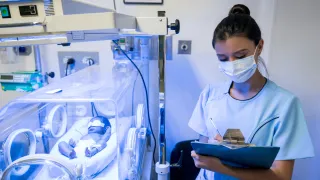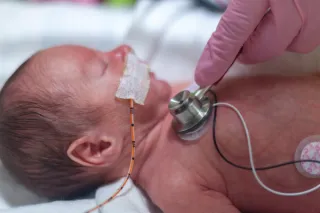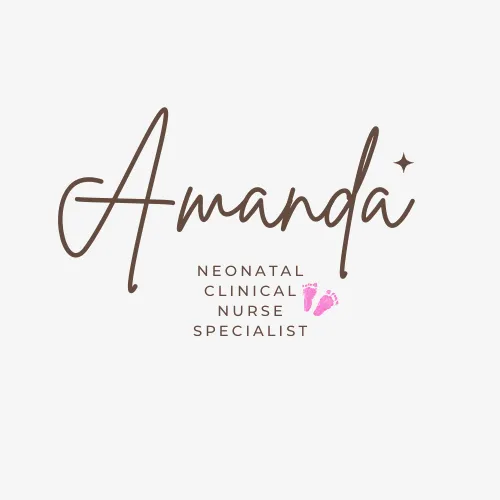
Welcome to Amanda's NICU Education




Hi! My name is Amanda. I'm a NICU nurse, Clinical Nurse Specialist, NICU Educator... basically your NICU BFF. If you want to talk NICU, I'm here for you! I love everything about NICU nursing and I'm eager to learn and share my knowledge with all my NICU friends.
I have been a NICU nurse since 2009 I am currently a Clinical Nurse Specialist in a Level IV NICU in Los Angeles.
I am passionate about educating the next generation of NICU nurses. I share my knowledge through platforms such as Instagram and Facebook and am excited to have you here on my website!
Click on the button below to sign up for my newsletter filled with NICU education and tips for all experience levels.

Not very many people love taking tests but as a self-acclaimed "forever student" who has taken (and passed) five different certification exams I am no longer afraid of tests! "Way to brag", you might be thinking but I want to help YOU pass your certification exam too!
Introducing Amanda's RNC-NIC Success digital course - your ultimate study companion!
Gain unlimited, on-demand access for life, ensuring you're primed to ace your certification exam.
I'm here to help you succeed and I can't wait for you to share with me that you PASSED the RNC-NIC EXAM!!!










NRP Updates
Have you heard? The Neonatal Resuscitation Program (NRP)just released its 9th Edition, and it brings some exciting updates that will shape how we prepare for those critical first minutes of life. Whether you’re due to renew soon or just love staying current, I’ve summarized the highlights for you! Let's review together...
🔄 What’s New in the 9th Edition
Here’s what stands out compared to the 8th Edition:
❤️ 1. New extra courses
Two new advanced tracks are rolling out:
NRP Cardiac Course– for newborns with congenital heart disease or post-operative physiology
Resuscitation in the NICU Course– designed for teams managing preterm or critically ill infants after delivery
These help bridge the gap between delivery-room resuscitation and ongoing stabilization.
💬 2. Teamwork + communication emphasized
There’s stronger focus on team performance, closed-loop communication, and role clarity during high-stress resuscitations — something every NICU nurse will recognize as essential.
🧠 3. “Science In-Service” feature
The AAP is adding a Science In-Service update module — short, focused learning on emerging evidence — to help instructors keep teaching current without waiting for another edition.
📚 4. Technology + access improvements
I love this! Learners will get integrated e-book access and improved RQI platform tools, making it easier to practice skills and track certification status. Institutions using the 8th Edition will have a smooth transition to 9th-Edition licenses.
🧐 So, what actually changed in the algorithm?
Let’s walk through the key practice changes you’ll notice, especially around cord management, ventilation, and pressures.
1. New Focus on Cord Management in the First Minute
One of the most visible changes is thatcord management is now explicitly built into the algorithm.
In the 9th Edition:
The very top of the algorithm now includes “Birth” and “Initiate Cord Management Plan”as actions within the first minute of life, highlighting that cord decisions are part of our resuscitation, not an afterthought.
The classic phrase “warm, dry, stimulate, position airway, suction” has been clarified. Routine suction is no longer embedded in that mantra. Suction is still available, but it is clearly “if needed,” not automatic.
2. Deferred Cord Clamping (DCC)
The 8th Edition already supported deferred cord clamping, especially for vigorous preterm infants. In the 9th Edition, the language specifies:
Who?
Most newborns who do not need immediate resuscitation are candidates for deferred cord clamping.
How long?
The emphasis shifts to deferring the clamp for at least 60 seconds (rather than the earlier 30–60s window).
So in practice, this means:
If the baby is vigorous and doesn’t need immediate resuscitation, your default posture should be:
“We’re leaving the cord intact for at least 60 seconds unless there is a clear reason not to.”
This will require communication with OB, midwives, and pediatrics before delivery—hence the new “Cord Management Plan” language at the top of the algorithm.
3. Umbilical Cord Milking
Cord milking has been controversial for a while, especially in very preterm infants. The 9th Edition clarifies its role in a more gestation-specific way:
Term and late-preterm (≈35–42 weeks)
For non-vigorous newborns in this gestational range who still haven’t responded to stimulation, intact umbilical cord milking from placenta may be considered as an alternative to early clamping.
Preterm 28–34 weeks
There is insufficient evidence to recommend routinely milking the intact cord. It’s not completely off the table, but it’s not endorsed as standard.
Preterm <28 weeks
Intact cord milking is not recommended due to association with increased risk of severe intraventricular hemorrhage (IVH).
4. Oxygen Targets: Table Starts at 2 Minutes
The target oxygen saturation table has been adjusted so that the first row now starts at 2 minutes of life (rather than 1 minute), with the familiar gradual rise thereafter.
Conceptually, we’re still aiming for:
Lower saturations in the first few minutes. Before the baby is born, their oxygen saturation is ~60%.
After birth, we expect a steady climb toward85–95% by 10 minutes
Evidence is suggesting that achieving 80-85% by 5 minutes of life is important.
Very preterm newborns, therefore, may require higher initial oxygen concentrations or more rapid titration.
Starting the table at 2 minutes better reflects how we actually assess and titrate in real life (that first minute goes fast).
Minor changes to the suggested initial FiO2
>35 weeks gestation: start at 21%
32-34 weeks gestation: start at 21-30%
<32 weeks gestation: start at ≥30%
5. Ventilation Rate and Initial PIP
Old (8th): 40–60 breaths/min
New (9th): 30–60 breaths/min– widening the lower end to 30 breaths/min.
A study found that using a rate of 30/min was associated with the highest CO2 clearance.
Initial Peak Inspiratory Pressure (PIP)
The 9th Edition simplifies and standardizes initial PIP:
Suggested initial PIP:25 cm H₂O
With an acceptable range adjusted by gestational age:
≥32 weeks:~25–30 cm H₂O
<32 weeks:~20–25 cm H₂O
This aligns with the 2025 AHA/AAP guidelines, which note that initial lung inflation usually occurs with PIP somewhere in the 20–30 cm H₂O range. AHA Journals
6. Ventilation Corrective Steps (MR. SOPA): Less Linear, More Clinical
The corrective steps haven’t disappeared, but the way you use them has shifted:
8th Edition:You were expected to walk through the steps sequentially until you achieved chest rise.
9th Edition:You’re encouraged to prioritize the step(s) that are most likely to help based on your assessment
Also, the timeframe for giving initial PPV a chance before changing something is clarified:
If the heart rate isn’t improving and you don’t see chest movement within about 15–30 seconds of starting PPV, you should start corrective actions.
This supports what you already know intuitively: when the baby isn’t improving, don’t just keep doing the same ineffective thing—change something quickly and deliberately.
7. Airway Devices and Tubes
A few important structural changes in the airway section:
Laryngeal Mask Airway (LMA)
Instead of being thought of only as a “rescue” after mask + failed intubation, the 9th Edition makes it clearer that ventilation can be initiated with a face mask or a laryngeal mask.
This is especially relevant where intubation skills/resources aren’t immediately available.
ETT size guidance updated
The weight cutoffs for2.5 mm vs 3.0 mm tubes are adjusted, including more precise guidance for infants<800 g
A2.0 mm tube is now explicitly acknowledged as an optional consideration in the tiniest infants.

ETT depth: “Tip-to-gum,” not “tip-to-lip”
The recommended depth reference moves from the lip to the upper gum line, to more consistently align with actual tracheal position in preterm and term babies.

What This Means for You as a NICU Nurse
If you’re reading this, you’re probably the person in your unit who:
Knows the guidelines…
Translates them into real-life workflows…
And gently nudges your team toward best practice.
Here are some ways you can use this newsletter:
Share at your next NRP update class, SIM, or huddle and ask:
“How will our practice change with DCC, cord milking, and the new PIP and rate guidance?”Start a conversation with OB/L&D partners about cord management plans, especially for late-preterm and high-risk term deliveries.
Use the updated PIP and ventilation rate ranges to coach newer nurses through what effective ventilation actually looks like (increasing HR, and chest rise), rather than just reciting numbers.
Want Help Integrating This Into Your Study & Practice?
If you’re preparing for your RNC-NIC or CCRN-N, or you just want to feel more confident the next time you’re at the warmer, these guideline shifts are exactly the type of content I break down inside my Neonatal Certification Review Course—with a lot more examples, cases, and practice questions.
You don’t have to memorize every line of the guidelines.
You do need a solid mental model of why we’re doing what we’re doing.
These updates show how neonatal resuscitation education continues to evolve — more team-based, scenario-driven, and data-informed. As nurses, staying current isn’t just about passing renewal; it’s about sharpening our confidence and readiness when seconds truly matter.

What questions do you have about the new guidelines?
Email me and let me know!
Stay Curious,
Amanda
© 2025 This content is for educational purposes and should complement, not replace, your unit's policies and procedures.

December 2023 Certification Review Webinar
NICU Certification Review



Ready to kickstart your journey to becoming a certified NICU nurse?
Look no further!
Grab my FREE E-Book packed with essential study and test-taking strategies for the RNC-NIC.
In the E-Book I give you the resources you need including the link to access the candidate guide, several types of books to study from, some of my favorite strategies, an outline of the content you should review, and a blank calendar for you to make your study plan!
Frequently Asked Questions About the RNC-NIC exam

What is the RNC-NIC?
The RNC-NIC is a competency-based exam that tests the specialty knowledge of nurses in the United States & Canada who care for critically ill newborns and their families.
The RNC-NICU is a nationally recognized certification that recognizes the registered nurse for their specialty knowledge and skill.

Who can take the RNC-NIC exam?
Nurses can take this exam after a minimum of two years experience in the NICU caring for critically ill newborns and their families.

Which books should I use?
I'm glad you asked! There are many excellent books to help you prepare for the RNC-NIC, I gathered ande describe each of them for you in my FREE e-book.
Is there a course to help me study?
Yes! Many hospitals host their own certification course and there are a few online courses. See my RNC-NIC test taking tips E Book for more information
What happens if I don't pass the exam?
If you don't pass the exam on your first try you can try again after 90 days. You will have to reapply after 90 days and pay a retest fee. There is no limit to the number of times you can take the exam (however a candidate can only sit for the exam twice per year).

Can I make more money if I take the RNC-NIC exam and get certified?
Yes! Many hospitals provide a raise or a bonus for nurses with specialty certifications. Hospitals also typically hire at a higher base salary when nurses have a certification.

Find me @amandasnicued on these channels or Email me
hey nurses don't miss out
© Copyright 2024. AmandasNICUEd. All rights reserved. | Terms & Conditions | Privacy Policy Contact: [email protected]

